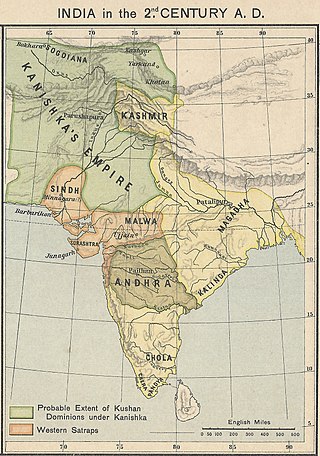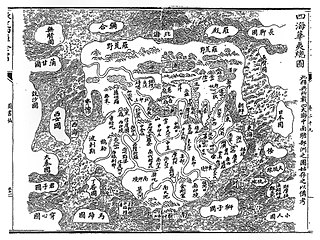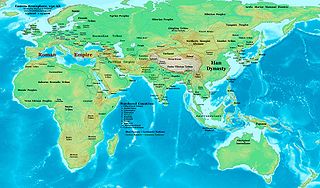Related Research Articles

The Alans were an ancient and medieval Iranic nomadic pastoral people who migrated to what is today North Caucasus – while some continued on to Europe and later North-Africa. They are generally regarded as part of the Sarmatians, and possibly related to the Massagetae. Modern historians have connected the Alans with the Central Asian Yancai of Chinese sources and with the Aorsi of Roman sources. Having migrated westwards and becoming dominant among the Sarmatians on the Pontic–Caspian steppe, the Alans are mentioned by Roman sources in the 1st century CE. At that time they had settled the region north of the Black Sea and frequently raided the Parthian Empire and the South Caucasus provinces of the Roman Empire. From 215 to 250 CE the Goths broke their power on the Pontic Steppe, thereby assimilating a sizeable portion of the associated Alans.

The Silk Road was a network of Eurasian trade routes active from the second century BCE until the mid-15th century. Spanning over 6,400 km (4,000 mi), it played a central role in facilitating economic, cultural, political, and religious interactions between the Eastern and Western worlds. The name "Silk Road" was first coined in the late 19th century, but some 20th- and 21st-century historians instead prefer the term Silk Routes, on the grounds that it more accurately describes the intricate web of land and sea routes connecting Central, East, South, Southeast, and West Asia as well as East Africa and Southern Europe.

The Kushan Empire was a syncretic empire formed by the Yuezhi in the Bactrian territories in the early 1st century. It spread to encompass much of what is now Tajikistan, Uzbekistan, Afghanistan, Pakistan, Eastern Iran and Northern India, at least as far as Saketa and Sarnath, near Varanasi, where inscriptions have been found dating to the era of the Kushan emperor Kanishka the Great.

Daqin (Chinese: 大秦; pinyin: Dàqín; Wade–Giles: Ta4-ch'in2; alternative transliterations include Tachin, Tai-Ch'in) is the ancient Chinese name for the Roman Empire or, depending on context, the Near East, especially Syria. It literally means "Great Qin"; Qin (Chinese: 秦; pinyin: Qín; Wade–Giles: Ch'in2) being the name of the founding dynasty of the Chinese Empire. Historian John Foster defined it as "the Roman Empire, or rather that part of it which alone was known to the Chinese, Syria". Its basic facets such as laws, customs, dress, and currency were explained in Chinese sources. Its medieval incarnation was described in histories during the Tang dynasty (618–907 AD) onwards as Fulin (Chinese: 拂菻; pinyin: Fúlǐn), which Friedrich Hirth and other scholars have identified as the Byzantine Empire. Daqin was also commonly associated with the Syriac-speaking Nestorian Christians who lived in China during the Tang dynasty.

Zhang Qian was a Chinese diplomat, explorer, and politician who served as an imperial envoy to the world outside of China in the late 2nd century BC during the Western Han dynasty. He was one of the first official diplomats to bring back valuable information about Central Asia, including the Greco-Bactrian remains of the Macedonian Empire as well as the Parthian Empire, to the Han dynasty imperial court, then ruled by Emperor Wu of Han.

Dayuan is the Chinese exonym for a country that existed in Ferghana valley in Central Asia, described in the Chinese historical works of Records of the Grand Historian and the Book of Han. It is mentioned in the accounts of the Chinese explorer Zhang Qian in 130 BCE and the numerous embassies that followed him into Central Asia. The country of Dayuan is generally accepted as relating to the Ferghana Valley, controlled by the Hellenistic city-state Alexandria Eschate, which can probably be understood as "Greco-Fergana city-state" in English language.

Ban Chao, courtesy name Zhongsheng, was a Chinese diplomat, explorer, and military general of the Eastern Han dynasty. He was born in Fufeng, now Xianyang, Shaanxi. Three of his family members—father Ban Biao, elder brother Ban Gu, younger sister Ban Zhao—were well known historians who wrote the historical text Book of Han, which recorded the history of the Western Han dynasty. As a Han general and cavalry commander, Ban Chao was in charge of administrating the "Western Regions" while he was in service. He also led Han forces for over 30 years in the war against the Xiongnu and re-established Han control over the Tarim Basin region. He was made Protector General of the Western Regions by the Han government for his efforts in protecting and governing the regions. Ban Chao is depicted in the Wu Shuang Pu by Jin Guliang.

The Book of the Later Han, also known as the History of the Later Han and by its Chinese name Hou Hanshu, is one of the Twenty-Four Histories and covers the history of the Han dynasty from 6 to 189 CE, a period known as the Later or Eastern Han. The book was compiled by Fan Ye and others in the 5th century during the Liu Song dynasty, using a number of earlier histories and documents as sources.

Sino-Roman relations comprised the contacts and flows of trade goods, information, and occasional travelers between the Roman Empire and the Han dynasty, as well as between the later Eastern Roman Empire and various successive Chinese dynasties that followed. These empires inched progressively closer to each other in the course of the Roman expansion into ancient Western Asia and of the simultaneous Han military incursions into Central Asia. Mutual awareness remained low, and firm knowledge about each other was limited. Surviving records document only a few attempts at direct contact. Intermediate empires such as the Parthians and Kushans, seeking to maintain control over the lucrative silk trade, inhibited direct contact between the two ancient Eurasian powers. In 97 AD, the Chinese general Ban Chao tried to send his envoy Gan Ying to Rome, but Parthians dissuaded Gan from venturing beyond the Persian Gulf. Ancient Chinese historians recorded several alleged Roman emissaries to China. The first one on record, supposedly either from the Roman emperor Antoninus Pius or from his adopted son Marcus Aurelius, arrived in 166 AD. Others are recorded as arriving in 226 and 284 AD, followed by a long hiatus until the first recorded Byzantine embassy in 643 AD.

Pacorus II was the King of Kings of the Parthian Empire from 78 to 110. He was the son and successor of Vologases I.
Guma (Goma) Town, also known as Pishan Town, is an ancient oasis town on the main caravan route between Khotan and Karghalik and, in Han times, the route left from here to go to Arachosia (Kandahar) through Hunza. It is located in the Taklamakan Desert, in the Xinjiang Uyghur Autonomous Region of the People's Republic of China, about 158 km southeast of Kashgar in modern Xinjiang, China.

Sea silk is an extremely fine, rare, and valuable fabric that is made from the long silky filaments or byssus secreted by a gland in the foot of pen shells. The byssus is used by the mussel to attach itself to the sea bed.
The Weilüe was a Chinese historical text written by Yu Huan between 239 and 265. Yu Huan was an official in the state of Cao Wei (220–265) during the Three Kingdoms period (220–280). Although not a formal historian, Yu Huan has been held in high regard among Chinese scholars. As per the texts, Roman travelers and traders of those times claimed that Roman elites were descendants of immigrants from ancient Chinese nobility and Parthian elites were descendants of ancient North Indian empires.
Yu Huan was a Chinese historian and travel writer of the state of Cao Wei during the Three Kingdoms period.

Serica was one of the easternmost countries of Asia known to the Ancient Greek and Roman geographers. It is generally taken as referring to North China during its Zhou, Qin, and Han dynasties, as it was reached via the overland Silk Road in contrast to the Sinae, who were reached via the maritime routes. A similar distinction was later observed during the Middle Ages between "Cathay" (north) and "Mangi" or "China" (south). The people of Serica were the Seres, whose name was also used for their region. Access to Serica was eased following the Han conquest of the Tarim Basin but largely blocked when the Parthian Empire fell to the Sassanids. Henry Yule summarized the classical geographers:
If we fuse into one the ancient notices of the Seres and their country, omitting anomalous statements and manifest fables, the result will be something like the following:—"The region of the Seres is a vast and populous country, touching on the east the Ocean and the limits of the habitable world, and extending west to Imaus and the confines of Bactria. The people are civilized, mild, just, and frugal, eschewing collisions with their neighbours, and even shy of close intercourse, but not averse to dispose of their own products, of which raw silk is the staple, but which include also silk-stuffs, fine furs, and iron of remarkable quality." That is manifestly a definition of the Chinese.

Indo-Roman trade relations was trade between the Indian subcontinent and the Roman Empire in Europe and the Mediterranean Sea. Trade through the overland caravan routes via Asia Minor and the Middle East, though at a relative trickle compared to later times, preceded the southern trade route via the Red Sea which started around the beginning of the Common Era (CE) following the reign of Augustus and his conquest of Egypt in 30 BCE.

Maës Titianus was an ancient Roman traveller of Macedonian culture. He was a Greek speaker who came from a family of merchants who had both Syrian and Roman identity. Maës sent an expedition that is recorded as having travelled farthest along the Silk Road from the Mediterranean world. In the early 2nd century CE or at the end of the 1st century BC, during a lull in the intermittent Roman struggles with Parthia, his party reached the famous Stone Tower, somewhere in or around the Pamir Mountains close to the border with China. Nothing is known of him, apart from a brief credit in Ptolemy's Geography, 1.11.7, whose knowledge of Maës was gained through an intermediary source, Marinus of Tyre:
"Marinus tells us that a certain Macedonian named Maen, who was also called Titian, son of a merchant father, and a merchant himself, noted the length of this journey [to the Stone Tower], although he did not come to Sera in person but sent other there"
Ban Yong, courtesy name Yiliao (宜僚), was the youngest son of the famous Chinese General, Ban Chao, and the nephew of the illustrious historian, Ban Gu, who compiled the Book of Han, the dynastic history of the Former Han dynasty.

Yancai was the Chinese name of an ancient nomadic state centered near the Aral Sea during the Han dynasty period. They are generally considered to have been an Iranian people of the Sarmatian group. After becoming vassals of the Kangju in the 1st century BC, Yancai became known as Alan. Yancai 奄蔡 is often connected to the Aorsi of Roman records, while 阿蘭 Alan has been connected to the later Alans.

The first documented relations between Ancient India and Ancient Rome occurred during the reign of Augustus, the first Roman Emperor.
References
- 1 2 "Ancient Rome and Ancient China: Did They Ignore Each Other?". TheCollector. 2022-11-08. Retrieved 2023-10-07.
- ↑ The Persian Gulf - which was then considered part of the Indian Ocean along with the Red Sea. Hill (2009), pp. 222, n. 9.3., 255, n. 10.13.
- ↑ Hill (2009), p. 5.
- ↑ Identification due to Hill, who argues against the previous identification Ctesiphon
- ↑ Hill (2009), p. 23.
- ↑ Hill (2009), pp. 24-25.
- ↑ Hill (2009), pp. 25, 27.
- ↑ Henry Yule, Cathay and the way thither, Hakluyt Society, 1866, I, p. lvii.
- ↑ Hill (2009), p. 279-280.
- ↑ Hill (2009), Appendix B, pp. 467-476; Hill (2004).